by Zachary Clemente
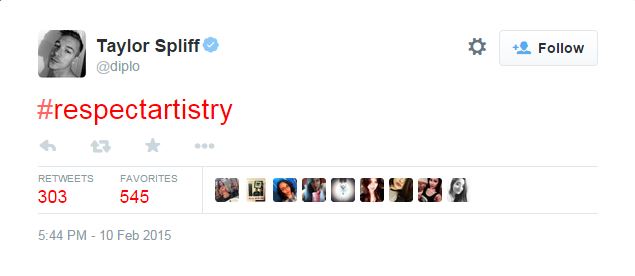
Last week, musician and producer Thomas Wesley Pentz (AKA Diplo) teased his upcoming collaboration with Missy Elliot on Snapchat, a video-sending service that’s being used as a new method of digital promotion among musicians. The video played a snipped of the track over a popular animated illustration by Rebecca Mock, a celebrated artist who has worked with The New York Times, The Walrus magazine, Nautilus online publication, and many more. Upon calling out Pentz on twitter for neither requesting permission to use her work or giving her credit, Mock was lambasted by Pentz and his followers. Much of the response Mock received is considered harassment, some of which is sexual in nature. He later uploaded the video to instagram, including a credit to her. The public side of the situation lasted about 2 days, resulting in a number of deleted tweets, a swell of write-ups, an apology of sorts, and potential legal action. Please be aware, the below contains potentially triggering verbal abuse.
How many times have you heard someone attempt to describe the internet? For me, it typically involves poor metaphors accompanied by wild gesticulation around my head – it’s a vast semi-connected mess of stuff that relates to other stuff, but not necessarily in a way that we see or care about. It has a constant and amorphous give and take of action and reaction nested so far up, down, and around that conventional structures such as copyright law are brutally difficult to apply. There’s plenty of argument as to why that lack of structure can be a useful thing, but I bring it up because it means we have to operate under our own rules built out of even older structures, such as morals and good faith. These rules aren’t written anywhere nor could they be as I can’t think of a place other than Google where literally everyone goes, so they propagate, much like videos of felines, virally; an evolutionary ethos if you will.
Where I’m going with this is even though the way the letter of the law, especially when it comes to copyrighted material, doesn’t easily shake out now that someone’s creation can be a collection of pixels which is technically “reproduced” every time it’s viewed on another screen – there are easily recognizable values to adhere to in the use and application of this material. This is something Pentz should have been aware of and therefore, disregarded by choice.

“The Aftershocks” by Rebecca Mock
What we get are a lot of slip-ups; someone will post something without credit and people will correct them. They’ll apologize then edit, credit, or pay and we’ll move on feeling, ideally, more knowledgable and satisfied with the overall experience. Unfortunately, this isn’t a common thing as one of the many, perhaps not well-exercised, behaviors that the internet enables is the speed with which we will share/retweet/reblog something. As an example, consider the number of times you’ve seen the first two panels of KC Green’s “On Fire” strip from his comic Gunshow without credit; it’s probably a lot. Community-based (read = not creator-based) aggregator platforms such as imgur, reddit, 9gag, and in the case of Pentz, Wifflegif, make it extraordinarily easy to view the action of sharing an animated gif or similar content as harmless fun. Nine times out of ten, I’m right there with you, but we have to acknowledge that we, as consumers of media, often take for granted the time and effort put into creating something and the fact that the little “share” button has become the preeminent way we show support.
Now, is this a bad thing? No, of course not – it’s a tool. But this tool isn’t a static object, it’s a means of communication that has foundational effects on how what is communicated is perceived, discussed, and framed. Sharing a book or a research paper is widely immune to this because you’re handling a source material that, by law, should be properly credited – all t’s crossed and i’s dotted. However, when a blog post (such as this one) is shared on twitter or facebook, there’s no guarantee that every embedded image is credited, and each subsequent sharer is less and less likely to ensure the inclusion of that credit. Instead of turtles, it’s the possibility of a passive application of the nonchalant disregard of creator ownership all the way down. Is it sometimes hard to tell how to approach this? Sure – but exercising a bit of caution can’t hurt.
Alright, where am I going with this, really?
Pentz should have known better is where this is going. For someone whose twitter feed is rife with easily digestible memes: images, gifs, hashtags used as inside jokes shared with millions, he is more than capable of knowing when something, like an image of a less-than-content cat with white text, is a product of the share-and-share-alike internet culture or when something is a labor of love and needs to be treated as such. As an experiment, I used Google’s image search, which allows you to make a query based on an uploaded image file, such as Mock’s “The Aftershocks”, embedded above. Here was my result:
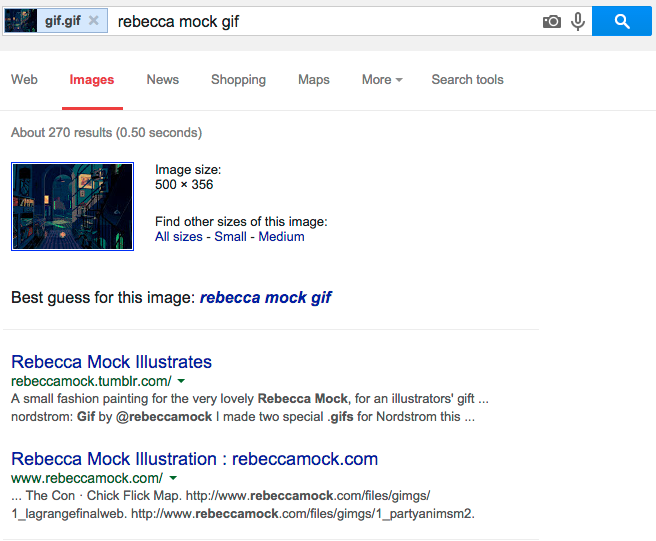 Almost like magic, right? Just for the naysayers out there: I created a new profile on my computer to ensure there was no associated search data or cookies present and renamed the file to gif.gif instead of a uniquely generated file name from tumblr. I chose to not edit the metadata of the image assuming that the uploader at Wifflegif did the same. The search completed in half a second, pulling up Mock’s name, blog, and portfolio website as the top hits. I posit that this process was so easy that even a savvy producer of digital music working on a computer 24/7 could do it, but I’ve been wrong before. This was Pentz’s first error, and easily the most excusable as there would still be a way to make amends afterwards.
Almost like magic, right? Just for the naysayers out there: I created a new profile on my computer to ensure there was no associated search data or cookies present and renamed the file to gif.gif instead of a uniquely generated file name from tumblr. I chose to not edit the metadata of the image assuming that the uploader at Wifflegif did the same. The search completed in half a second, pulling up Mock’s name, blog, and portfolio website as the top hits. I posit that this process was so easy that even a savvy producer of digital music working on a computer 24/7 could do it, but I’ve been wrong before. This was Pentz’s first error, and easily the most excusable as there would still be a way to make amends afterwards.
Unfortunately Pentz’s subsequent responses to Mock’s tweet calling him out and those of her supporters ruined any chance of recompense; some choice examples are featured below.
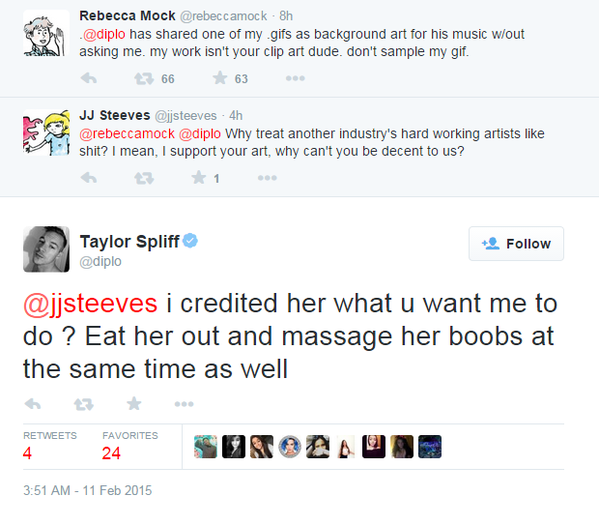
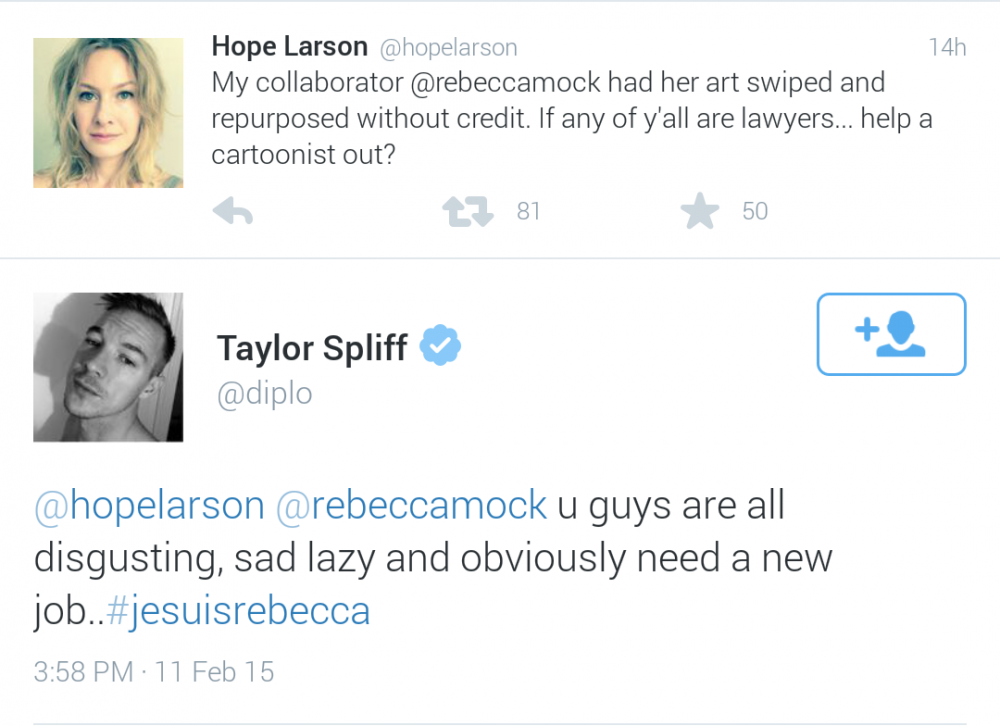
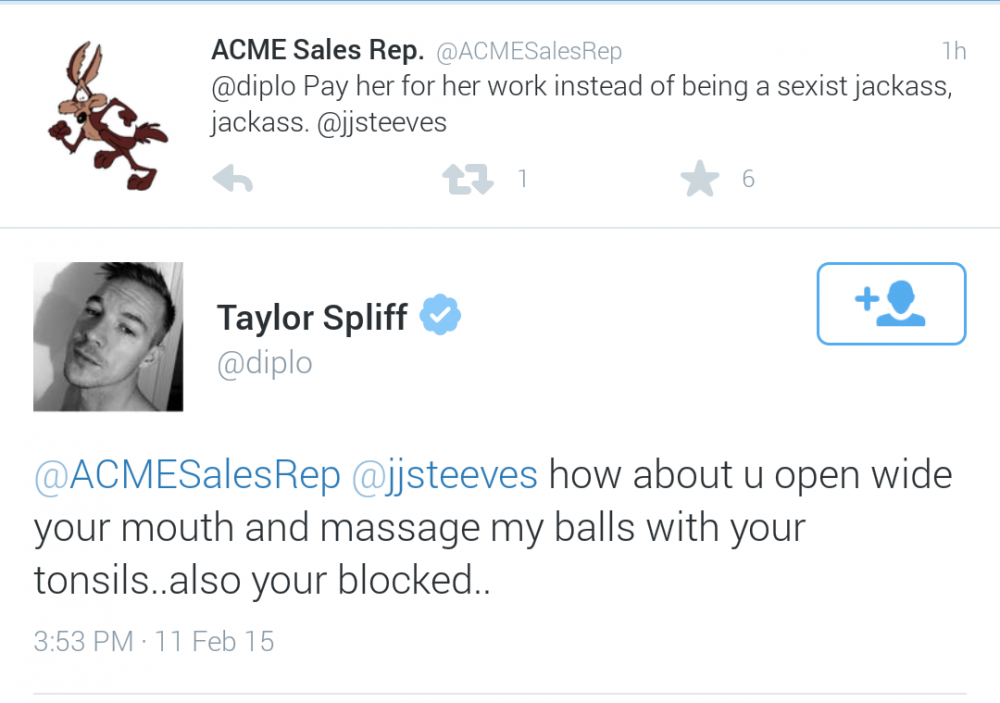
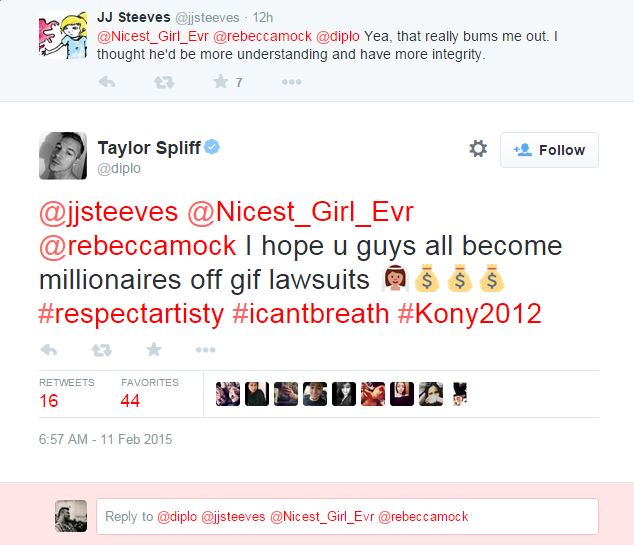
To me there’s a singular, and often under-discussed, place that all of these responses are coming from: Pentz’s feelings of entitlement. They come in readily customizable colors and sizes for all applications and can become quite pervasive if left unchecked; but the primary one here is that of being male.
Not only were Pentz’s responses abusive and flippant, they were wrapped in that soft nougat of everyday misogyny to make that made-to-serve blend we know as sexual harassment. It starts with a grotesquely sexually-charged rehash of a “have her cake and eat it too” strike aimed at Mock, moves to the emotionally abusive and gendered attack on Mock’s collaborator Hope Larson with some targeted misuse of a rather politically-feverish hashtag, slips back into cut and dry sexual harassment, and finishes with a brazen apathy for the effect Mock and her supports will have on his life complete with a touch of his, now patently gross, misuse of politically charged hashtags. Was that exhausting to read? Just try to imagine how it must have been for Mock. I doubt that the gendered form in which this harassment was conducted would have occurred if Mock and Larson were male; Pentz would’ve had to make do with attacks that were less sexual nature.
Clearly Pentz is of the “in for a penny, in for a pound” school of thought as it’s not only the comments directed at Mock that can be attributed to his entitlement.
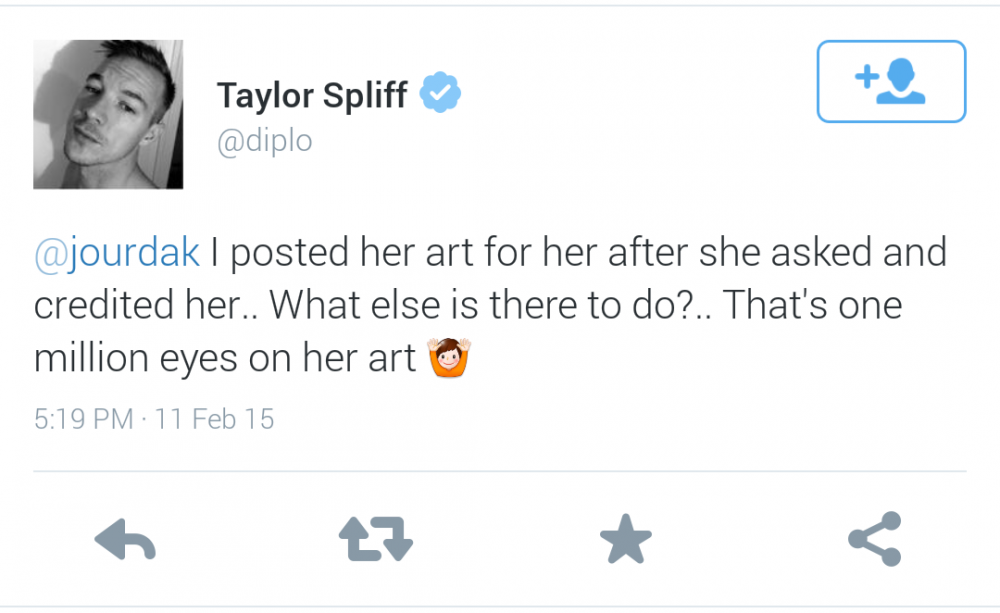 Here’s where Pentz’s disconnect really hits home for me: he genuinely thinks what he has said and did wasn’t wrong and likely still doesn’t; we’ll get into his apology later. He exposed her art to his large number of followers, that’s a good thing right? Eh – yes and no. Sure, she may ultimately get more work out of this debacle – but that wasn’t Pentz’s choice to make. He did not receive consent from Mock to utilize her work as a means of promoting his own. Yes, many people saw her animation; but inside the frame of his own promotion – undermining her work and agency as an artist. The disregard of this socially required and well-known form of consent is the most worrying aspect of this situation to me as it’s the genesis of all other actions Pentz has taken. Further proof of this is him linking her instagram account to the permanent upload of the offending video as a tepid means of offering credit; no consideration was taken into how she uses her account (accord to Mock – it’s more of a personal scrapbook) and has only opened up more avenues for Pentz’s irate fans to harass her and her friends. Pentz just doesn’t seem to give a damn about how this situation is negatively affecting peoples’ lives and probably never will. So why did he care now? Why did he even engage?
Here’s where Pentz’s disconnect really hits home for me: he genuinely thinks what he has said and did wasn’t wrong and likely still doesn’t; we’ll get into his apology later. He exposed her art to his large number of followers, that’s a good thing right? Eh – yes and no. Sure, she may ultimately get more work out of this debacle – but that wasn’t Pentz’s choice to make. He did not receive consent from Mock to utilize her work as a means of promoting his own. Yes, many people saw her animation; but inside the frame of his own promotion – undermining her work and agency as an artist. The disregard of this socially required and well-known form of consent is the most worrying aspect of this situation to me as it’s the genesis of all other actions Pentz has taken. Further proof of this is him linking her instagram account to the permanent upload of the offending video as a tepid means of offering credit; no consideration was taken into how she uses her account (accord to Mock – it’s more of a personal scrapbook) and has only opened up more avenues for Pentz’s irate fans to harass her and her friends. Pentz just doesn’t seem to give a damn about how this situation is negatively affecting peoples’ lives and probably never will. So why did he care now? Why did he even engage?
Because he can and no harm will come to him. Voilà, meet entitlement’s secret ruler: privilege.
While scrolling through his twitter feed as this unfolded, I saw many of his fans decrying Mock’s first tweet as unwarranted, stating that she should have contacted him privately to address the issue. Sure – that seems reasonable enough, except…how? In preparation for this post, I spent a good hour or so hunting far and wide for contact information that wasn’t his social media platforms and found nothing to work with. All I turned up were two email addresses associated with his record label, Mad Decent; I sent a request for a statement into that void and doubt that anything will come of it. I don’t know what they expect of Mock, but I doubt that there’s some kind of secret society of people who have more than 5K followers on twitter that exists exclusively so they can contact each other privately.
At the end of the day, what we have is a clashing of two different worlds: the comics world and the music industry where nothing is one-to-one. Mock is a freelance illustrator who has to handle her own day-to-day business whereas Pentz likely has a team of people working under him to manage his various projects; he has plenty of literal and figurative gates barring people from interacting with him in a way that he deems unfit. It’s hard to see this as a problem of any kind as both exist and work in a normal situation, in context to their respective fields. However, for this you simply need to take a look at their twitter followers to see that Pentz has been happily surrounded in an echo chamber of support; it’s impossible to meet an aggressor on the field when their side approximately outnumbers yours 260:1. He doesn’t know how good he has it and doesn’t care how awful he’s made it for Mock.
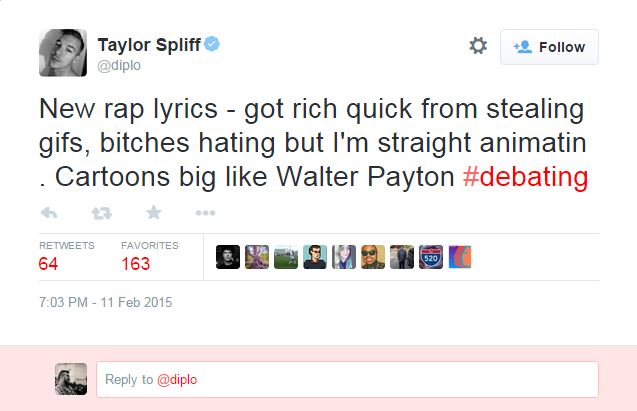 Now, the apology (also screencapped here in case it gets removed). I don’t know about you, but I really believe that he wrote it with earnest and thought his way through each and every bizarre use of incomplete ellipses…then promptly cast the whole thing aside as if nothing had happened. Befitting his previous behavior, he excuses himself by stating “I’m sorry thats my nature” and “I’m just a joking person and i don’t even take myself serious so how can i take you guys seriously.” Half-hearted at best, Pentz’s attempt to address Mock’s concerns only highlight the problem at play: he never got her permission to use her art and doesn’t see that as a bad thing. Even worse were the provided explanations for his terrible behavior, ending the note with “so maybe this is also a future apology to everyone on the internet who follows me”. We’re left with Pentz telling Mock that this situation is little more than a future anecdote to him; he can’t even complete an apology to her without undermining the validity of her experience.
Now, the apology (also screencapped here in case it gets removed). I don’t know about you, but I really believe that he wrote it with earnest and thought his way through each and every bizarre use of incomplete ellipses…then promptly cast the whole thing aside as if nothing had happened. Befitting his previous behavior, he excuses himself by stating “I’m sorry thats my nature” and “I’m just a joking person and i don’t even take myself serious so how can i take you guys seriously.” Half-hearted at best, Pentz’s attempt to address Mock’s concerns only highlight the problem at play: he never got her permission to use her art and doesn’t see that as a bad thing. Even worse were the provided explanations for his terrible behavior, ending the note with “so maybe this is also a future apology to everyone on the internet who follows me”. We’re left with Pentz telling Mock that this situation is little more than a future anecdote to him; he can’t even complete an apology to her without undermining the validity of her experience.
There’s a lesson to be learned here, I like to believe. There’s an opportunity for us to do better and find common ground when a dispute like this crops up. In this case, Pentz could have contacted Mock privately to diffuse the problem and address her concerns – creator to creator. Hell, in the most ideal of situations, they may have decided to collaborate in the future, sharing a laugh over the amusing way their paths crossed. However, thanks to Pentz – this is not to be. I urge you to check out this post from game designer Joshua A.C. Newman who resolved a situation with another game creator, Matt Rivaldi, over two similarly named titles hitting Kickstarter around the same time in a way that benefited both parties. He makes it look easy, because it is.
You can find Rebecca Mock’s work here and support her by purchasing a print or four. The image “The Aftershocks” was originally commissioned for an article on Medium.
by Zachary Clemente
In October, comics veteran Patrick Broderick announced that he was returning to DC for an unnamed project after 20 years. A few days ago, he posted the below on his facebook page, requesting that people who are cosplay personalities or represent conventions who build their show to include cosplay and media guests should not invite him and went on to suggest that the inclusion of those individuals bring no value to the show and that the people in charge of these shows are not a positive force in comics. This is an open letter to Mr. Broderick, whose works includes: The Fury of Firestorm, Micronauts, Creature Commandos, Batman: Year Three and many others.
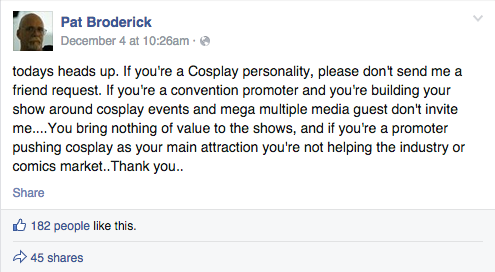
Dear Mr. Broderick,
Can I call you Pat? Cool – thanks. I want to talk to you about the you made comments a few days back that have drummed up quite a din in the comics world. I’m concerned that you haven’t really been keeping close tabs on what many folks have been discussing when it comes to cosplay at conventions and to a lesser extent, media/entertainment guests. Before we get into, let’s be clear: I think you and everyone who has sided with you it wrong as wrong can be; let’s talk about why.
Before I go further, I’d like to discuss the history of costuming at conventions and cosplay. “Cosplay” is a portmanteau of the words “costume” and “play” that was coined by Japanese reporter Nobuyuki Takahasi, who wrote up his experiences at the 1984 World Science Fiction Convention for the My Anime magazine. That was around time you were working on Sun Runners for Pacific Comics and Eclipse Comics, yeah? Secondly, it’s important to point out that it was at the 4th annual San Diego Comic-Con where their first masquerade was held – a now-common convention event where costumers are encouraged to show off their work. It was a big enough deal that June Foray (voice of Rocky the Squirrel) emceed. That was 1974, right around the time where you started working for DC, unless I’m mistaken.
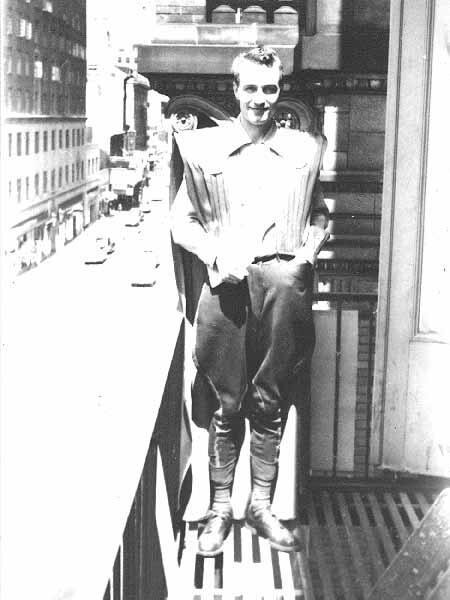
Ackerman in his “futuristicostume”, designed by his friend Myrtle Douglas
To run the gamut, I want to know if you’ve heard of Forrest J. Ackerman – I hope so because even I have. For those unclear, Forrest “Forry” Ackerman (born in 1916) was the collector of science fiction books and movie memorabilia and, arguably, the most important science fiction fan to have lived. The influence of his work in the world of science fiction is nothing short of monumental; hell, he coined the phrase “sci-fi”. I’d also like to point out that he was costuming in 1939 – two decades before you were born. For the first ever World Science Fiction Convention, Ackerman showed of his slick duds, dubbed his “futuristicostume” – looking akin to an early superhero. He, in essence, was the first ever cosplayer. The point of all of this is that what cosplaying, as a pursuit and a sanctioned and supported activity, has been around in the convention scene essentially as long as you have, if not longer. Perhaps not to the degree that it is presently, but around nevertheless. You are saying that something that has been part of the very marrow of comic conventions for as long as you’ve been working in comics “brings nothing of value” and is “not helping the industry or [the] comics market”. How do you codify that arrangement?
Pat, I urge you to ponder where these statements are coming from. Who are these people not helping and what kind of help, exactly, does the comics market require? Additionally, what is your definition of the “value” that needs to be brought into a convention space to be worthy? I press you on this because I think your notions of what a convention should be and what they have, for the most part, evolved into are very different and that troubles you. Due to this disconnect, this is now how I read your request:
You bring nothing of value to the shows me. You’re not helping the industry or comics market me.
All of this is part and parcel to the true issue that your “request” is wrought with: entitlement. Not to beat around the bush, the first reason most comics pros will complain about cosplayers at conventions is that it detracts from their sales. I don’t truly know if this is your exact issue, but your voice is one of many such voices decrying the presence and the support of cosplaying at conventions; that cacophony is what I aim to address.
I’m sorry to break the news, but attendees at conventions owe you nothing. Like you, every attendee had to pay to be there and has their own agenda which does not always include dropping money on comics, toys, paraphernalia, or the various other items typically sold on the floor. Like buying anything, essentially anywhere – the choice of when, what, and how someone purchases is up to the consumer. I’m not trying to say that it’s exclusively on the the shoulders of the retailers and exhibitors to ensure that they make any sales at all; I’m saying that suggesting that one factor in the economic ecology of conventions is the problem is laughably narrow-minded and indicative of a dangerous unwillingness to take a step back from an exhibitor table and take a thoughtful look around.
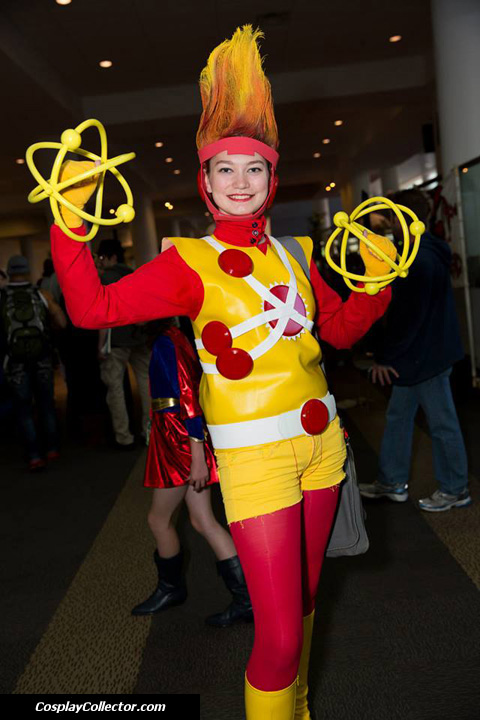
Pat, would you say her passion is of no value?
What kind of help does the comics industry require? I think the most easily addressed need is that comics need more readers and you know – I think that’s (mostly) being worked on. Comics, especially those published by DC and Marvel are typically not very accessible to new readers. Runs spanning hundreds of issues, complex interwoven plot arcs, and more character death/rebirth/reboot than you could shake 52 sticks at. Other companies have made a far more concerted effort to accommodate with quality books, but they don’t yet garner the percentage of sales that the Big 2 get. However, the numbers are changing and that indicates a change in the interests of comics readers, and subsequently, the change in the demographic of comics readers. The biggest growing demographic in comics readership is women – especially teenagers. Quick poll: who is most likely to be cosplaying at a convention? You got it: women. I genuinely believe that these two factors, among others, are correlated. The more contemporary convention has more reasons for people to attend and one of those reasons is to cosplay. These spaces are for more than just comics now, especially at SDCC or NYCC which haven’t been for a decade or more, but that’s all part of knowing what show is best for your needs.
Pat, you ask that conventions that push cosplay and media guests as a main attraction shouldn’t invite you. You know, I don’t think any of them will have a problem with that.
Maybe your SDCC or NYCC just aren’t the sort of shows that you want to exhibit at anymore. That’s totally fine, feel free to check out this intense list of shows that run annually. You are sure to find something at least once (if not twice) a month that accommodates for your needs. That’s a personal preference, not a problem. Really, this whole thing can be a non-issue for you.
What irks me, however, is the aforementioned cacophony of pros shaking their proverbial fist at the generally younger attendees in their outfits and crying foul; all with the misplaced irritation Abe Simpson harbors against an atmospheric mass. This isn’t a generational thing, though age is absolutely a factor; it’s a blame thing. They’re desperate to pin one easily targetable group of people for being the genesis of change that it’s so easy to forget that an audience doesn’t have direct voice in how conventions are run. It’s not like cosplayers go to ReedPOP’s offices to tell Lance Fensterman that there needs to be more cosplay events or they’ll bust his kneecaps. There’s isn’t some super-influential underground society of geeky seamstresses who appear on the oaken boardroom table of San Diego Comic-Con’s planning committee demanding that the masquerade go two hours longer. The notion of blaming cosplayers for the changing climate of conventions is putting the cart before the horse then trying to blame the cart for the lack of motion.
What’s actually happening is that the passion of costuming, that’s existed as long as the modern American comics industry, has found a rejuvenated home with a younger demographic and conventions have, smartly, provided them a platform to celebrate that passion with other like-minded folks alongside dovetailing interests. This is thing that should be celebrated, not decried; quit trying to ostracize a huge group of potential new comics readers because they celebrate their interests differently. Literally any fandom that centralizes around comics have been revitalized by an active cosplay community. On the scale of expressing passion for a thing, spending months making a costume to wear at a convention is way up there, just under getting a very large and visible tattoo. It’s time to accept that buying original comic pages and attending panels aren’t the only ways to show that you’re a fan of something at a convention. I urge you to check out the #CosplayersAREfans tag on twitter to see tangible proof that people who cosplay buy more than enough at conventions.
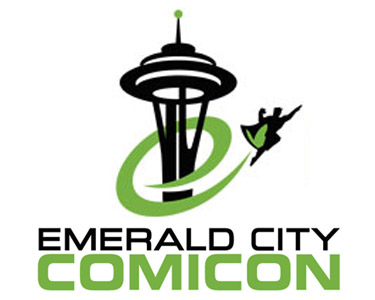
I want to settle on a positive note, so I’m going to highlight one of the very best shows I attended this past year and why I think it was a perfect combination of cosplay, media guests, and comics. I’m talking, of course, about Seattle’s Emerald City Comicon, which runs annually in late March. First off – it’s pretty big: around 70,000 attendees. There’s a TON of space, so it’s easy to accommodate for cosplayer needs. In fact, there were 2 bookable fan meet-up spaces that were considered part of the official schedule. The size also affords the convention the ability to section off a large swath of the floor for their media guests so all it happens out of the way of the show floor, easing any confusion of congestion. All that said, I was blown away by the sheer percentage of exhibitors that were comics creators. It was easily 75%, the rest being a combination of games dealers, vendors, publishers, art collectives, and the alike. Additionally, they don’t skimp on their comics guest list – having a mix of 150+ comic writers, illustrators, and colorists already on the docket for the upcoming show in 2015. To top it all off, they ran the most successful campaign addressing the harassment of cosplayers – an unfortunately common problem at conventions. It was openly discussed, with promotion spread far and wide weeks before the event. Coupled with the prominent signage all around the show floor, ECCC’s “Cosplay is not Consent” campaign is an excellent example of a convention addressing a genuine problem appropriately with ease. It’s a brilliant show, Pat. You should check it out.
As my once-almost-editor David Harper often says, we’re all in this together. There’s the thought I always want to come from whenever I see this sort of attitude voiced by you and many others. There’s a good future available to us in comics and you’re holding us back from it. Thanks for reading Pat, I hope you reconsider your stance.
All The Best,
Zachary Clemente
PS: If you really think selfies are the highest expression of narcissism, I suggest you don’t look at any European art after 1433 as Jan van Eyck’s Portrait of a Man is commonly thought to be the first self-portrait.
PPS: After finishing this letter, I noticed that you posted a followup to his original request. It elaborates on your point and it doesn’t change my response; your voice is once of many that needs to be addressed. However, there was one comment you made that drives me up the wall:
…but keep in mind that these shows started and continue to be [PG] rated family friendly events so consider the children who attend with their parents and the uncomfortable position you’re putting the parents in with your designs.
Sure, some of these outfits are a bit revealing, but have you taken a look at the majority of the canonical female-bodied superhero costumes DC and Marvel have to offer? Not much to work with there, Pat. Additionally, if you’re going to suggest that cosplayers should be cognizant of only presenting kid-friendly content, let’s be sure to take down every artists’ cheesecake pinup of Mary Jane Watson, Supergirl, Wonder Woman, or I don’t know – pick literally any female-bodied superhero and someone will be selling a print of her in a “sexy” (read: exploitative) pose. This is the only thing you’ve said I’m not willing to play ball with Pat. You want exclusively “child friendly” content at cons? Then you’re going to have to make sure nary an artist has visible work that falls outside this category and then we’ll talk. Please don’t act like cosplayers are the problem here; you’re holding them to a standard that straight-up doesn’t exist on the show floor. Pat, this is the first image I get when I do an image search for “Superheroine”. Tell me how that image is PG while the costume would not be.
 Almost like magic, right? Just for the naysayers out there: I created a new profile on my computer to ensure there was no associated search data or cookies present and renamed the file to gif.gif instead of a uniquely generated file name from tumblr. I chose to not edit the metadata of the image assuming that the uploader at Wifflegif did the same. The search completed in half a second, pulling up Mock’s name, blog, and portfolio website as the top hits. I posit that this process was so easy that even a savvy producer of digital music working on a computer 24/7 could do it, but I’ve been wrong before. This was Pentz’s first error, and easily the most excusable as there would still be a way to make amends afterwards.
Almost like magic, right? Just for the naysayers out there: I created a new profile on my computer to ensure there was no associated search data or cookies present and renamed the file to gif.gif instead of a uniquely generated file name from tumblr. I chose to not edit the metadata of the image assuming that the uploader at Wifflegif did the same. The search completed in half a second, pulling up Mock’s name, blog, and portfolio website as the top hits. I posit that this process was so easy that even a savvy producer of digital music working on a computer 24/7 could do it, but I’ve been wrong before. This was Pentz’s first error, and easily the most excusable as there would still be a way to make amends afterwards. Here’s where Pentz’s disconnect really hits home for me: he genuinely thinks what he has said and did wasn’t wrong and likely still doesn’t; we’ll get into his apology later. He exposed her art to his large number of followers, that’s a good thing right? Eh – yes and no. Sure, she may ultimately get more work out of this debacle – but that wasn’t Pentz’s choice to make. He did not receive consent from Mock to utilize her work as a means of promoting his own. Yes, many people saw her animation; but inside the frame of his own promotion – undermining her work and agency as an artist. The disregard of this socially required and well-known form of consent is the most worrying aspect of this situation to me as it’s the genesis of all other actions Pentz has taken. Further proof of this is him linking her instagram account to the permanent upload of the offending video as a tepid means of offering credit; no consideration was taken into how she uses her account (accord to Mock – it’s more of a personal scrapbook) and has only opened up more avenues for Pentz’s irate fans to harass her and her friends. Pentz just doesn’t seem to give a damn about how this situation is negatively affecting peoples’ lives and probably never will. So why did he care now? Why did he even engage?
Here’s where Pentz’s disconnect really hits home for me: he genuinely thinks what he has said and did wasn’t wrong and likely still doesn’t; we’ll get into his apology later. He exposed her art to his large number of followers, that’s a good thing right? Eh – yes and no. Sure, she may ultimately get more work out of this debacle – but that wasn’t Pentz’s choice to make. He did not receive consent from Mock to utilize her work as a means of promoting his own. Yes, many people saw her animation; but inside the frame of his own promotion – undermining her work and agency as an artist. The disregard of this socially required and well-known form of consent is the most worrying aspect of this situation to me as it’s the genesis of all other actions Pentz has taken. Further proof of this is him linking her instagram account to the permanent upload of the offending video as a tepid means of offering credit; no consideration was taken into how she uses her account (accord to Mock – it’s more of a personal scrapbook) and has only opened up more avenues for Pentz’s irate fans to harass her and her friends. Pentz just doesn’t seem to give a damn about how this situation is negatively affecting peoples’ lives and probably never will. So why did he care now? Why did he even engage? Now, the apology (also screencapped here in case it gets removed). I don’t know about you, but I really believe that he wrote it with earnest and thought his way through each and every bizarre use of incomplete ellipses…then promptly cast the whole thing aside as if nothing had happened. Befitting his previous behavior, he excuses himself by stating “I’m sorry thats my nature” and “I’m just a joking person and i don’t even take myself serious so how can i take you guys seriously.” Half-hearted at best, Pentz’s attempt to address Mock’s concerns only highlight the problem at play: he never got her permission to use her art and doesn’t see that as a bad thing. Even worse were the provided explanations for his terrible behavior, ending the note with “so maybe this is also a future apology to everyone on the internet who follows me”. We’re left with Pentz telling Mock that this situation is little more than a future anecdote to him; he can’t even complete an apology to her without undermining the validity of her experience.
Now, the apology (also screencapped here in case it gets removed). I don’t know about you, but I really believe that he wrote it with earnest and thought his way through each and every bizarre use of incomplete ellipses…then promptly cast the whole thing aside as if nothing had happened. Befitting his previous behavior, he excuses himself by stating “I’m sorry thats my nature” and “I’m just a joking person and i don’t even take myself serious so how can i take you guys seriously.” Half-hearted at best, Pentz’s attempt to address Mock’s concerns only highlight the problem at play: he never got her permission to use her art and doesn’t see that as a bad thing. Even worse were the provided explanations for his terrible behavior, ending the note with “so maybe this is also a future apology to everyone on the internet who follows me”. We’re left with Pentz telling Mock that this situation is little more than a future anecdote to him; he can’t even complete an apology to her without undermining the validity of her experience.












Google Image search is pretty easy… a simple right-click in Google Chrome will shortcut searching.
I did that recently for a blog post.
I found a random photo of Times Square, noticed a watermark, and left a note on the owner’s Deviant Art page. I then removed the image, and directed readers to the DA page.
http://torstenadair.blogspot.com/2015/02/sherlocking-times-square.html
So… what does @MissyElliott think about all this?
Really awesomely on thoughtfully written piece, Zachary. Thank you.
Reading this it amazes me (short of the rampant misogyny in Dilpo’s responses) how close this story is in detail to the Shia LaBeouf story from a couple of years back.
I really wish there was an charitable organization (ala HERO or ACTOR) that worked on behalf of artists for copyright infringement – and that includes legal action towards other artists, no matter how popular they might be. I suspect Pentz would have a totally different attitude towards this if he got a letter from an actual lawyer and he realized it wasn’t an ‘I can outspend you’ type scenario.
My sympathies lie with her, but if it were just plagiarism it would be none of my business. These things happen all the time and I don’t know her. It’s the way he reacted after being caught that’s the issue. It’s like the difference between seeing a stranger in the street being yelled at, where I’d probably think the guy is a jerk but go on about my day, and them being abused where I’d most definitely get involved or call the police. I say to boycott anything this Diplo is involved with or anyone that would work with him.
Ugh? Who is this dick? People have problems with Kanye, and this person exists?
I honestly feel that this is just a culture clash. If she’d have replied with “Thanks for using my gif, you cunt!” Everything would have been fine. You have to speak to us Brits in the manner we’re accustomed to.
the gif was playing on the background of my laptop during a post on snapchat.. .
i googled Earthquake gif..
and her gif was made for an online mag so she actually doesnt own that content .. they do
when asked to credit her – i reposted on my instagram at her request.
then she blocked me and i was attacked by 1000 cartoonists..
which in turn i began to antagonize because I’m an asshole..
did i ever write anything misogynistic to rebecca?.. no..
did i write to her followers..? yes..
did i post more snapchats with other gifs.. yes.. like a dancing football player and a dancing japanese woman..
did i benefit from this fiasco.?.
yes only because it got more people who don’t know who i am acquainted with me and my music for best or for worse..
so i guess its win win.
am in sorry or did i learn my lesson..?
no i guess not..
will i continue to look at websites with art on them probably . will i stop using snapchat?
no.
am i an asshole.?
yes.
I am a woman entrepreneur whose innovative ideas got stolen by larger companies. I detect that Diplo became angry and abusive when he got found out stealing someone else’s work. It’s more emotionally and financially rewarding to give credit where credit is due, pay up if you need to, shake hands, and collaborate even more in the future. All successful artists follow this Golden Rule. Maybe Diplo is a two-bit artist who has to steal to achieve success. How would he feel if someone else stole his work and never gave him any credit?
Hey, everybody! Apparently it’s OK to be misogynistic and vile to someone as long as you don’t address them directly.
When Cartoonists Attack
Stop talking about yours and other peoples’ genitals for two seconds.
Diplo: the worst thing to begin with the letters D-I-P-L-O since Diplock Courts.
Lol to everyone taking this over the top serious, especially Mock. If Diplo was using your gif to profit then by all means speak out, but you being dramatic just shows how much of a money hungry struggling artist you are that got lost in the limelight and wants some publicity again. You should be thankful that Diplo even mentioned you because now more people will know who you are and what you do, cause I sure didn’t before this lol….yes more lol.